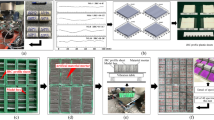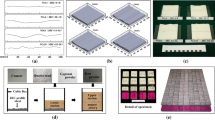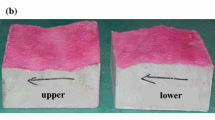Abstract
Under shearing, joint asperities get sheared off and damaged. Moreover, shearing and sliding and the interaction between normal and shear stresses occur simultaneously. The nonlinearity of the shear strength envelope is closely related to the joint material, normal stress level, and morphological characteristics. This study analyzed the correlation of the friction angle with the normal stress level to overcome overestimation or underestimation at relatively low or high normal stress levels in the JRC–JCS empirical model. A hyperbolic function was adopted to describe the degradation of friction for different normal stress levels, and the modified non-linear shear criterion \(\tau = \sigma_{\text{n}} \tan (\phi_{\text{r}} + \Delta \phi /(1 + a\sigma_{\text{n}} /{\text{JCS}}))\) was proposed. Furthermore, the proposed model avoids direct connection to the surface morphology, which is convenient for practical use. Statistical analysis of the experimental data and comparison with the JRC–JCS model verified the validity of the proposed model and present an excellent method for characterizing the non-linearity of the failure envelope for the rock joint.

(data from Tang and Wong 2016)


(Reproduced with permission from Maksimović 1996)



(from Maksimović 1996)








Similar content being viewed by others
Abbreviations
- \(\sigma_{\text{n}}\) :
-
Normal stress
- \(\phi\) :
-
Friction angle
- \(\sigma_{\text{t}}\) :
-
Tensile strength
- \(\sigma_{\text{T}}\) :
-
Transition stress in Patton model
- \(\phi_{\text{P}}\) :
-
Friction angle of peak shear strength
- \(\phi_{\text{b}}\) :
-
Basic friction angle
- \(d_{\text{n}}\) :
-
Peak dilation angle
- \(s_{\text{n}}\) :
-
Contribution of asperities degradation in friction angle
- \(\phi_{\text{r}}\) :
-
Residual friction angle
- \(\tau\) :
-
Peak shear strength
- JRC:
-
Joint roughness coefficient
- JCS:
-
Joint compressive strength
- \(P_{\text{N}}\) :
-
Median angle pressure in Maksimović model
- \(c_{\text{T}}\) :
-
Apparent cohesion in Maksimović model
- \(\phi_{\text{MAX}}\) :
-
Friction angle of the initial surface roughness of the discontinuity
- \(\sigma_{\text{c}}\) :
-
Uniaxial compressive of intact rock
- \(\Delta \phi\) :
-
Difference between \(\phi_{\text{MAX}}\) and \(\phi_{\text{r}}\)
References
Asadollahi P, Tonon F (2010) Constitutive model for rock fractures: revisiting Barton’s empirical model. Eng Geol 113:11–32
Bahaaddini M, Sharrock G, Hebblewhite BK (2013) Numerical direct shear tests to model the shear behaviour of rock joints. Comput Geotech 51:101–115
Bandis S, Lumsden A, Barton N (1983) Fundamentals of rock joint deformation. Int J Rock Mech Min Sci Geomech Abstr 20:249–268
Barton N (1973) Review of a new shear-strength criterion for rock joints. Eng Geol 7:287–332
Barton N (2013) Shear strength criteria for rock, rock joints, rockfill and rock masses: problems and some solutions. J Rock Mech Geotech Eng 5:249–261
Barton N (2016) Non-linear shear strength for rock, rock joints, rockfill and interfaces. Innov Infrastruct Solut 1:30
Barton N, Choubey V (1977) The shear strength of rock joints in theory and practice. Rock Mech 10:1–54
Grasselli G (2006) Manuel Rocha medal recipient shear strength of rock joints based on quantified surface description. Rock Mech Rock Eng 39:295
Grasselli G, Egger P (2003) Constitutive law for the shear strength of rock joints based on three-dimensional surface parameters. Int J Rock Mech Min Sci 40:25–40
Homand F, Belem T, Souley M (2001) Friction and degradation of rock joint surfaces under shear loads. Int J Numer Anal Meth Geomech 25:973–999
Lee H, Park Y, Cho T, You K (2001) Influence of asperity degradation on the mechanical behavior of rough rock joints under cyclic shear loading. Int J Rock Mech Min Sci 38:967–980
Maksimović M (1992) New description of the shear strength for rock joints. Rock Mech Rock Eng 25:275–284
Maksimović M (1996) The shear strength components of a rough rock joint. Int J Rock Mech Min Sci Geomech Abstr 33:769–783
Misra A (2002) Effect of asperity damage on shear behavior of single fracture. Eng Fract Mech 69:1997–2014
Patton FD (1966) Multiple modes of shear failure in rock. In: Proc. 1st international congress on rock mechanics, Lisbon, pp 509–513
Serrano A, Olalla C, Galindo RA (2014) Micromechanical basis for shear strength of rock discontinuities. Int J Rock Mech Min Sci 70:33–46
Tang ZC, Wong LNY (2016) New criterion for evaluating the peak shear strength of rock joints under different contact states. Rock Mech Rock Eng 49:1191–1199
Tang ZC, Jiao YY, Wong LNY, Wang XC (2016) Choosing appropriate parameters for developing empirical shear strength criterion of rock joint: review and new insights. Rock Mech Rock Eng 49:1–12
Wan W, Liu J, Liu J (2018) Effects of asperity angle and infill thickness on shear characteristics under constant normal load conditions. Geotech Geol Eng 1–7. https://doi.org/10.1007/s10706-018-0447-5
Xia CC, Tang ZC, Xiao WM, Song YL (2014) New peak shear strength criterion of rock joints based on quantified surface description. Rock Mech Rock Eng 47:387–400
Yang J, Rong G, Hou D, Peng J, Zhou C (2016) Experimental study on peak shear strength criterion for rock joints. Rock Mech Rock Eng 49:821–835
Zhang X, Jiang Q, Chen N, Wei W, Feng X (2016) Laboratory investigation on shear behavior of rock joints and a new peak shear strength criterion. Rock Mech Rock Eng 49:3495–3512
Zhao J (1997) Joint surface matching and shear strength part B: JRC–JMC shear strength criterion. Int J Rock Mech Min Sci 34:179–185
Acknowledgements
This paper gets its funding from project (51474249, 51774322, 41562016) supported by National Natural Science Foundation of China; Project (2016CX019) supported by Innovation-driven Plan in Central South University; Project (2017zzts534) supported by the Fundamental Research Funds for the Central Universities of Central South University. The authors wish to acknowledge these supports.
Author information
Authors and Affiliations
Corresponding author
Rights and permissions
About this article
Cite this article
Wang, H., Lin, H. Non-linear Shear Strength Criterion for a Rock Joint with Consideration of Friction Variation. Geotech Geol Eng 36, 3731–3741 (2018). https://doi.org/10.1007/s10706-018-0567-y
Received:
Accepted:
Published:
Issue Date:
DOI: https://doi.org/10.1007/s10706-018-0567-y




